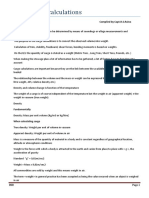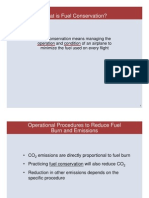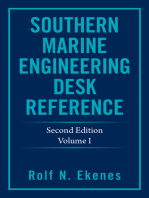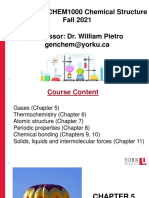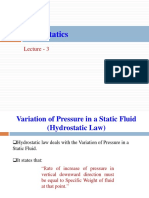0 ratings0% found this document useful (0 votes)
36 viewsFinal Project
The document discusses how weather and atmospheric conditions impact aviation. It notes that the atmosphere is primarily nitrogen and oxygen and can be thought of as a fluid. Weather is crucial for flight planning considerations like fuel consumption, runways to use, flight time, and safety. Headwinds increase flight time and fuel needs while tailwinds decrease them. Pilots must consider wind direction for takeoffs and landings. Visibility is also impacted by cloud heights, which can be estimated from temperature and dew point differences. Barometric pressure affects altimeter readings, so pilots must adjust settings between locations to obtain accurate altitude readings.
Uploaded by
api-251321195Copyright
© © All Rights Reserved
Available Formats
Download as PPT, PDF, TXT or read online on Scribd
0 ratings0% found this document useful (0 votes)
36 viewsFinal Project
The document discusses how weather and atmospheric conditions impact aviation. It notes that the atmosphere is primarily nitrogen and oxygen and can be thought of as a fluid. Weather is crucial for flight planning considerations like fuel consumption, runways to use, flight time, and safety. Headwinds increase flight time and fuel needs while tailwinds decrease them. Pilots must consider wind direction for takeoffs and landings. Visibility is also impacted by cloud heights, which can be estimated from temperature and dew point differences. Barometric pressure affects altimeter readings, so pilots must adjust settings between locations to obtain accurate altitude readings.
Uploaded by
api-251321195Copyright
© © All Rights Reserved
Available Formats
Download as PPT, PDF, TXT or read online on Scribd
You are on page 1/ 23
Aviation and
Meteorology
What is the atmosphere
Primarily nitrogen (80%) and oxygen
(20%)
Can be thought of as a fluid
Protects earth in many ways
Weather is a crucial component for
flight.
Flight planning
Fuel consumption
Runways to use
Flight time
Safety
Visibility
Fuel consumption
As aircraft travel through the air,
they measure the speed that air is
passing the pitot tube.
Headwind
Tailwind
Headwind and Tailwind
Headwinds will cause the aircraft to
travel through more air to reach a
destination
Tail winds will cause the aircraft to
travel through less air to reach a
destination
Headwind
Since there is more air to pass
through with a headwind, It will take
longer and more fuel will be needed.
The opposite is true for a tailwind.
Runways
Fixed wing aircraft takeoff and land
into the wind, therefore it is
important to know the direction and
speed of the surface winds
Example
KSLC International primarily utilizes
runways, 34/16 and 35/17
Runway 34/16 has a magnetic
alignment with 340 going north and 160
going south.
With North winds we can expect 34
or 35
Crosswinds
Cessna 172 has a demonstrated
crosswind takeoff and landing at 14
knots
Problem
Wind speed 20
knots
Wind direction 330
Runway 35
What is the
crosswind
component?
Answer
Subtract wind
direction (330)
from runway
heading (350) =20
degrees
20 degrees at 20
knots is a 7 knot
crosswind
Safe to takeoff
Visibility
Visual Flight Rules (VFR) flights need
to stay 1000 feet above clouds, 500
feet beneath clouds and 2000 feet
horizontally from clouds.
Cloud height
Find the difference from field temp to
the dew point in centigrade.
Divide by 2.5
Multiply by 1000 to get the base of
the clouds above ground level (AGL).
Sample Problem
20 degrees C with a dew point of
15C
20-15=5
5 divided by 2.5=2
2 X 1000=2000 feet AGL
Dont forget to add field elevation
KSLC 4227+2000= 6227 Cloud base
above sea level.
Pressure Altitude
The height above 29.92 barometric
pressure
Equals sea level on a standard day of
15C
Density Altitude
Is pressure altitude corrected for
nonstandard temperature.
Atmospheric Pressure
Standard day 15C at 29.92
barometric pressure in inches of
mercury.
Temperature and barometric
pressure obtained through automatic
terminal information services (ATIS)
Barometric Pressure
Altimeter is a pressure reading
instrument that converts pressure
reading to an altitude.
Atmosphere decrease in weight by 1
inch of mercury every 1000 feet.
Altimeter
Set to the current
barometric
pressure in the
Kollsman window
In this example it
is set to 29.90
Altimeter
Altimeter must be set at run up,
every 30 minutes during flight and
upon descending to final destination.
If not adjusted the indicated altitude
can be incorrect.
Altimeter
Here we se the indicated alt. 5000. True
alt. decreased 1000 since the destination
is 1 of mercury lighter than the origin
airport.
Altimeter
The saying is from high to low look
out below.
Meaning from a high pressure to a low
pressure, the ground is going to be
closer than indicated if the altimeter is
not adjusted to the current pressure.
Summary
The atmosphere and its ever
changing state is an important factor
in aviation.
It is essential that pilots are able to
interpret data from weather stations
for flight planning.
Bibliography
The Atmosphere an introduction to
meteorology 11th edition. Lutgens
Tarbuck
Pilots handbook of aeronautical
knowledge. FAA
You might also like
- Form 1 Geography Notes New Curr Online Only100% (1)Form 1 Geography Notes New Curr Online Only94 pages
- Air Navigation On Demand August Session 2023No ratings yetAir Navigation On Demand August Session 20233 pages
- Math For Pilots: Airplane Performance Density AltitudeNo ratings yetMath For Pilots: Airplane Performance Density Altitude7 pages
- Performance Calculations: Calculation ExamplesNo ratings yetPerformance Calculations: Calculation Examples9 pages
- Renewable Energy Systems Wind Power Systems Sources: Masters (Chapter 6)No ratings yetRenewable Energy Systems Wind Power Systems Sources: Masters (Chapter 6)132 pages
- Aviation Ii Training 2023: Basic Weather Observation and Reporting BYNo ratings yetAviation Ii Training 2023: Basic Weather Observation and Reporting BY30 pages
- Group 1 - Introduction To Pneumatics - Complete For Chapter 1 and 2No ratings yetGroup 1 - Introduction To Pneumatics - Complete For Chapter 1 and 2115 pages
- Air Compressor: BMMM 2333 - Hydraulic and Pneumatic TechnologyNo ratings yetAir Compressor: BMMM 2333 - Hydraulic and Pneumatic Technology34 pages
- 6ENT1065 (6ENT1070) Aerospace Performance, Propulsion, Design (& Manufacture)No ratings yet6ENT1065 (6ENT1070) Aerospace Performance, Propulsion, Design (& Manufacture)51 pages
- Aircraft Performance Flight Simulation Lab Solution: γ) γ) C computed from ρ C computed fromNo ratings yetAircraft Performance Flight Simulation Lab Solution: γ) γ) C computed from ρ C computed from3 pages
- VND - Openxmlformats Officedocument - Presentationml.presentation&rendition 1No ratings yetVND - Openxmlformats Officedocument - Presentationml.presentation&rendition 1211 pages
- Laboratory: Flight Demonstrator Wind Tunnel Report Aerospace Propulsion & AerodynamicsNo ratings yetLaboratory: Flight Demonstrator Wind Tunnel Report Aerospace Propulsion & Aerodynamics10 pages
- Railway Engineering & Runway EngineeringNo ratings yetRailway Engineering & Runway Engineering42 pages
- CHAPTER 11. Air Data Computer (ADC) : 11.1. General 11.1.1 AirspeedNo ratings yetCHAPTER 11. Air Data Computer (ADC) : 11.1. General 11.1.1 Airspeed8 pages
- Compressor Design, Triangle Velocity & ExampleNo ratings yetCompressor Design, Triangle Velocity & Example26 pages
- Aircraft Air Conditioning & PressurisationNo ratings yetAircraft Air Conditioning & Pressurisation34 pages
- Final Air Conditioning and RefrigerationNo ratings yetFinal Air Conditioning and Refrigeration28 pages
- Ventilation of Switchgear and Transformer RoomsNo ratings yetVentilation of Switchgear and Transformer Rooms8 pages
- Southern Marine Engineering Desk Reference: Second Edition Volume IFrom EverandSouthern Marine Engineering Desk Reference: Second Edition Volume INo ratings yet
- The Samora Machel and Helderberg Conspiracies and Other South African Air AccidentsFrom EverandThe Samora Machel and Helderberg Conspiracies and Other South African Air AccidentsNo ratings yet
- Chapter 5 (Pressure and Deformation in Solids) Class 9 Physics FBSIE 2025No ratings yetChapter 5 (Pressure and Deformation in Solids) Class 9 Physics FBSIE 202520 pages
- Memoirs of The Literary and PhilosophicaNo ratings yetMemoirs of The Literary and Philosophica617 pages
- DR. ALFRED MÜLLER Digital Barometer DB278 D2No ratings yetDR. ALFRED MÜLLER Digital Barometer DB278 D21 page
- Mechanical Properties of Fluids _ PYQs ~ PhysicsNo ratings yetMechanical Properties of Fluids _ PYQs ~ Physics2 pages
- IM BSCE 3 - Hydraulics 1 Chapter 2 2021-2022No ratings yetIM BSCE 3 - Hydraulics 1 Chapter 2 2021-202231 pages
- Operation Guide 3259: About This Manual Things To Check Before Using The WatchNo ratings yetOperation Guide 3259: About This Manual Things To Check Before Using The Watch14 pages
- Product Application Guide: Inlet Pressure CorrectionNo ratings yetProduct Application Guide: Inlet Pressure Correction2 pages
- Ielts Listening - Unit Test DATE: FULL NAME: Instruction: Write Your Answers On Your Answer Sheet.No ratings yetIelts Listening - Unit Test DATE: FULL NAME: Instruction: Write Your Answers On Your Answer Sheet.5 pages
- Animal Climatology: Elements of ClimateNo ratings yetAnimal Climatology: Elements of Climate53 pages
- Humidity/Barometer/Temp. Data Recorder: ISO-9001, CE, IEC1010No ratings yetHumidity/Barometer/Temp. Data Recorder: ISO-9001, CE, IEC10102 pages
- Math For Pilots: Airplane Performance Density AltitudeMath For Pilots: Airplane Performance Density Altitude
- Renewable Energy Systems Wind Power Systems Sources: Masters (Chapter 6)Renewable Energy Systems Wind Power Systems Sources: Masters (Chapter 6)
- Aviation Ii Training 2023: Basic Weather Observation and Reporting BYAviation Ii Training 2023: Basic Weather Observation and Reporting BY
- Group 1 - Introduction To Pneumatics - Complete For Chapter 1 and 2Group 1 - Introduction To Pneumatics - Complete For Chapter 1 and 2
- Air Compressor: BMMM 2333 - Hydraulic and Pneumatic TechnologyAir Compressor: BMMM 2333 - Hydraulic and Pneumatic Technology
- 6ENT1065 (6ENT1070) Aerospace Performance, Propulsion, Design (& Manufacture)6ENT1065 (6ENT1070) Aerospace Performance, Propulsion, Design (& Manufacture)
- Aircraft Performance Flight Simulation Lab Solution: γ) γ) C computed from ρ C computed fromAircraft Performance Flight Simulation Lab Solution: γ) γ) C computed from ρ C computed from
- VND - Openxmlformats Officedocument - Presentationml.presentation&rendition 1VND - Openxmlformats Officedocument - Presentationml.presentation&rendition 1
- Laboratory: Flight Demonstrator Wind Tunnel Report Aerospace Propulsion & AerodynamicsLaboratory: Flight Demonstrator Wind Tunnel Report Aerospace Propulsion & Aerodynamics
- CHAPTER 11. Air Data Computer (ADC) : 11.1. General 11.1.1 AirspeedCHAPTER 11. Air Data Computer (ADC) : 11.1. General 11.1.1 Airspeed
- Southern Marine Engineering Desk Reference: Second Edition Volume IFrom EverandSouthern Marine Engineering Desk Reference: Second Edition Volume I
- The Samora Machel and Helderberg Conspiracies and Other South African Air AccidentsFrom EverandThe Samora Machel and Helderberg Conspiracies and Other South African Air Accidents
- Chapter 5 (Pressure and Deformation in Solids) Class 9 Physics FBSIE 2025Chapter 5 (Pressure and Deformation in Solids) Class 9 Physics FBSIE 2025
- Operation Guide 3259: About This Manual Things To Check Before Using The WatchOperation Guide 3259: About This Manual Things To Check Before Using The Watch
- Product Application Guide: Inlet Pressure CorrectionProduct Application Guide: Inlet Pressure Correction
- Ielts Listening - Unit Test DATE: FULL NAME: Instruction: Write Your Answers On Your Answer Sheet.Ielts Listening - Unit Test DATE: FULL NAME: Instruction: Write Your Answers On Your Answer Sheet.
- Humidity/Barometer/Temp. Data Recorder: ISO-9001, CE, IEC1010Humidity/Barometer/Temp. Data Recorder: ISO-9001, CE, IEC1010








